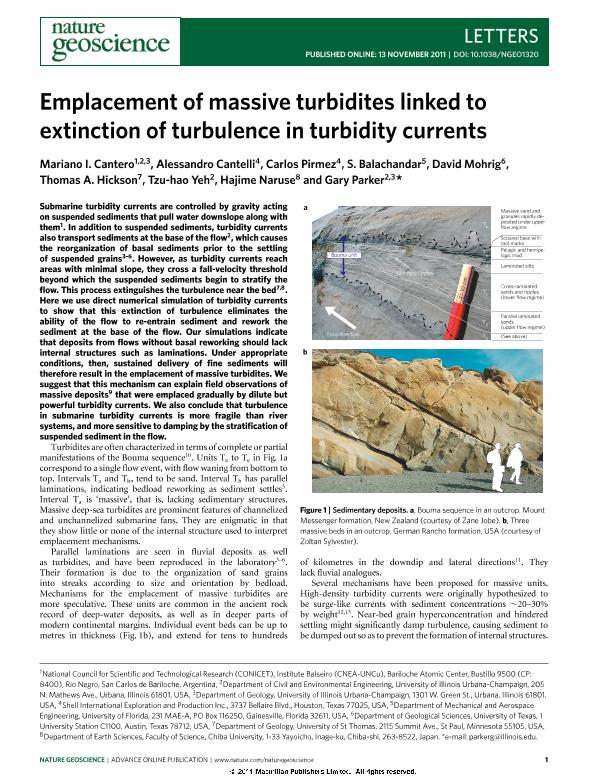Mostrar el registro sencillo del ítem
dc.contributor.author
Cantero, Mariano Ignacio

dc.contributor.author
Cantelli, Alessandro
dc.contributor.author
Pirmez, Carlos
dc.contributor.author
Balachandar, S.
dc.contributor.author
Mohrig, David
dc.contributor.author
Hickson, Thomas
dc.contributor.author
Yeh, Tzu-hao
dc.contributor.author
Naruse, Hajime
dc.contributor.author
Parker, Gary
dc.date.available
2017-01-13T17:24:18Z
dc.date.issued
2012-01
dc.identifier.citation
Cantero, Mariano Ignacio; Cantelli, Alessandro; Pirmez, Carlos; Balachandar, S.; Mohrig, David; et al.; Emplacement of massive turbidites linked to extinction of turbulence in turbidity currents; Nature Publishing Group; Nature Geoscience; 5; 1-2012; 42-45
dc.identifier.issn
1752-0894
dc.identifier.uri
http://hdl.handle.net/11336/11294
dc.description.abstract
Unlike river systems which are controlled by the gravitational pull of water, submarine turbidity currents are controlled by the gravitational pull of suspended sediments. The suspended sediments in turn pull water downslope along with them. Turbidity currents also transport sediments at the base of the flow, which causes the reorganization of basal sediments prior to the settling of suspended grains. However, as turbidity currents reach areas with minimal slope, they cross a threshold beyond which the suspended sediments begin to stratify the flow. This process extinguishes the turbulence near the bed. Here we use direct numerical simulation (DNS) to show that this extinction of turbulence eliminates the ability of the flow to re-entrain sediment and rework the sediment in the bed of the flow. Our simulations indicate that the lack of reworking at the base of the flow leads to deposits that lack internal structures such as laminations. Sustained delivery of suspended sediments will therefore result in the emplacement of massive turbidites. We suggest that this mechanism can explain field observations of massive deposits that were emplaced gradually by dilute but powerful turbidity currents. We also conclude that turbulence in submarine turbidity currents is more fragile than that of river systems, and more sensitive to damping by the stratification of suspended sediment in the flow.
dc.format
application/pdf
dc.language.iso
eng
dc.publisher
Nature Publishing Group

dc.rights
info:eu-repo/semantics/openAccess
dc.rights.uri
https://creativecommons.org/licenses/by-nc-sa/2.5/ar/
dc.subject
Turbidity Currents
dc.subject
Sedimentary Deposits
dc.subject
Direct Numerical Simulation
dc.subject.classification
Geociencias multidisciplinaria

dc.subject.classification
Ciencias de la Tierra y relacionadas con el Medio Ambiente

dc.subject.classification
CIENCIAS NATURALES Y EXACTAS

dc.title
Emplacement of massive turbidites linked to extinction of turbulence in turbidity currents
dc.type
info:eu-repo/semantics/article
dc.type
info:ar-repo/semantics/artículo
dc.type
info:eu-repo/semantics/publishedVersion
dc.date.updated
2017-01-06T20:03:02Z
dc.journal.volume
5
dc.journal.pagination
42-45
dc.journal.pais
Reino Unido

dc.description.fil
Fil: Cantero, Mariano Ignacio. Consejo Nacional de Investigaciones Científicas y Técnicas; Argentina. Comisión Nacional de Energía Atómica. Gerencia del Area de Investigación y Aplicaciones No Nucleares. Gerencia de Física (Centro Atómico Bariloche); Argentina. Universidad Nacional de Cuyo; Argentina. University Of Illinois At Urbana; Estados Unidos
dc.description.fil
Fil: Cantelli, Alessandro. Shell International Exploration and Production Inc.; Estados Unidos
dc.description.fil
Fil: Pirmez, Carlos. Shell International Exploration and Production Inc.; Estados Unidos
dc.description.fil
Fil: Balachandar, S.. University Of Florida; Estados Unidos
dc.description.fil
Fil: Mohrig, David. University Of Texas; Estados Unidos
dc.description.fil
Fil: Hickson, Thomas. University of St Thomas. Department of Geology; Estados Unidos
dc.description.fil
Fil: Yeh, Tzu-hao. University Of Illinois At Urbana; Estados Unidos
dc.description.fil
Fil: Naruse, Hajime. Chiba University. Faculty of Science. Department of Earth Sciences; Japón
dc.description.fil
Fil: Parker, Gary. University Of Illinois At Urbana; Estados Unidos
dc.journal.title
Nature Geoscience

dc.relation.alternativeid
info:eu-repo/semantics/altIdentifier/url/http://www.nature.com/ngeo/journal/v5/n1/full/ngeo1320.html
dc.relation.alternativeid
info:eu-repo/semantics/altIdentifier/doi/http://dx.doi.org/10.1038/ngeo1320
Archivos asociados
